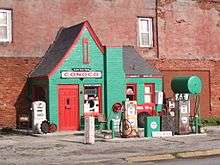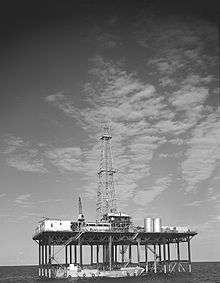Conoco
 | |
| Division | |
| Industry | Oil and gas |
| Fate |
|
| Founded | 1875 (as Continental Oil and Transportation Company) Ogden, Utah, U.S. |
| Founder | Isaac Elder Blake |
| Defunct | 2002 |
| Headquarters | , U.S. |
| Products | Petroleum |
| Parent | Phillips 66 |
| Website | www |
ConocoPhillips is no longer affiliated with P66
Conoco Inc.
Conoco Inc. is a defunct American oil company founded by Isaac Elder Blake in 1875 as the Continental Oil and Transportation Company.[1] It is now a brand of gasoline and service station in the United States which belongs to Phillips 66 following the spin-off of ConocoPhillips' downstream assets in May 2012.[2][3]
History


The Continental Oil and Transportation Company was founded by Isaac Elder Blake in 1875.[1][4] Based in Ogden, Utah, the company distributed oil, kerosene, benzene, and other products in the western United States.[5] Continental Oil Company was acquired by Standard Oil Company in 1884 and was spun off from Standard Oil during the Standard Oil divestiture in 1911. The main office was later moved to Ponca City, Oklahoma, when in 1929, Marland Oil Company (founded by exploration pioneer E. W. Marland) acquired the Continental Oil Company.[4][6] Marland Oil acquired the assets (subject to liabilities) of Continental Oil Company for a consideration of 2,317,266 shares of stock. At that time, Marland Oil changed its name to Continental Oil Company. The acquisition gave Conoco the red triangle symbol previously used by Marland which would become Conoco's logo from 1930 to 1970, when the now-familiar capsule logo was adopted.
The company ran into early trouble when, shortly after acquisition, it was hit by the Great Crash of October 1929. Conoco became a key supplier to the United States government during World War II.[7]

Under the leadership of Leonard F. McCollum, Conoco grew from a regional company to a global corporation in the years after World War II. Another rough patch for the company came during the 1970s oil crisis, from which it did not recover until 1981, when Conoco became a subsidiary of former rival DuPont.
In 1981, cash rich and wanting to diversify, Seagram Company Ltd. engineered a takeover of Conoco. Although Seagram acquired a 32.2% stake in Conoco, DuPont was brought in as a white knight by the oil company and entered the bidding war. In the end, Seagram lost out in the Conoco bidding war. In exchange for its stake in Conoco Inc, it became a 24.3% owner of DuPont. By 1995, Seagram was DuPont's largest single shareholder with four seats on the board of directors.
In 1998, DuPont and Conoco parted ways.[8] When the independent Conoco went public in October 1998, under a retooled name, Continental Oil Company, it resulted in the largest IPO in history. Conoco bought what was left of Gulf Oil's Canadian operations in 2002. Conoco merged with Phillips Petroleum Company in 2002 to form ConocoPhillips.
Corporate headquarters
Before the merger, Conoco had its headquarters in what is now the current ConocoPhillips headquarters in the Energy Corridor of Houston; the complex was formerly known as the Conoco Center.[9][10]
The headquarters of Conoco moved to Houston, Texas, in 1949.[4] In 1965, the headquarters moved to Manhattan, New York City. In 1972, the headquarters moved to Stamford, Connecticut; in Stamford Conoco occupied space in the three story High Ridge Park complex.[11] In 1982, DuPont announced that Conoco's headquarters would move from Stamford to Wilmington, Delaware.[12] The move occurred in 1982.[8] Edward G. Jefferson, the chairperson of DuPont, said that the headquarters relocation was to bring the head workforces of DuPont and Conoco together. DuPont also announced that it was closing the Conoco offices in Stamford; the lease in the Stamford complex was originally scheduled to expire in 1992.[11]
Conoco-Iran deal
In 1995, Conoco Inc. was awarded a contract by Iran to develop a huge offshore oilfield in the Persian Gulf. It was the first energy agreement involving Iran and the United States since Washington severed relations with Tehran in 1980. The contract was signed after three years of negotiations.[13] However, the company dropped the plan after the White House announced that President Bill Clinton would issue a directive blocking all such transactions on grounds of national security.[14]
References
- "1909-1875". ConocoPhillips. Retrieved 2018-07-11.
- "Archived copy". Archived from the original on 2014-05-08. Retrieved 2014-05-08.CS1 maint: archived copy as title (link)
- "Archived copy". Archived from the original on 2014-05-08. Retrieved 2014-05-08.CS1 maint: archived copy as title (link)
- "ConocoPhillips Announces Museum Plans For Ponca City and Bartlesville" (Press release). ConocoPhillips. May 13, 2005. Retrieved August 1, 2013.
- "Our History: 1875–1909". ConocoPhilips. Archived from the original on June 15, 2013. Retrieved August 1, 2013.
- "History of ConocoPhillips Canada". ConocoPhilips Canada. Archived from the original on 18 September 2012. Retrieved 2 September 2012.
- Banham, Russ (2000). Conoco: 125 Years of Energy. Lyme, Conn.: Greenwich Publishing Group, Inc. p. 67. ISBN 0944641385.
- "DuPont, Conoco Splitting Archived 2001-07-15 at the Wayback Machine." Ponca City News. Monday May 11, 1998. Retrieved on February 3, 2010.
- ""Write Conoco!."". Archived from the original on February 19, 1997. Retrieved 2017-04-20.CS1 maint: BOT: original-url status unknown (link) Conoco Inc. February 19, 1997. Retrieved on January 16, 2010.
- ""Conoco World Headquarters Address."". Archived from the original on November 1, 1996. Retrieved 2017-04-20.CS1 maint: BOT: original-url status unknown (link) Conoco Inc. November 1, 1996. Retrieved on January 17, 2010.
- "Conoco Offices to Close." The New York Times at The Spokesman-Review. Sunday November 7, 1982. C10. Google News 48 of 67. Retrieved on February 3, 2010.
- "DU PONT TO MOVE CONOCO'S OFFICES." The Philadelphia Inquirer. November 6, 1982. D08. Retrieved on February 3, 2010.
- Iran Signs Oil Deal With Conoco; First Since 1980 Break With U.S. The New York Times - March 7,1995
- CLINTON TO ORDER A TRADE EMBARGO AGAINST TEHERAN The New York Times - May 1,1995
Sources
- Mathews, John Joseph (1992). Life and Death of an Oil Man: The Career of E. W. Marland (1951 ed.). Norman, OK: University of Oklahoma Press. ISBN 0-8061-1238-7.
- Moody’s Industrial Manual. 1960.